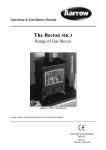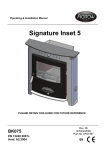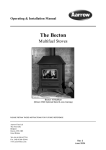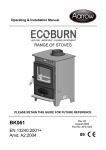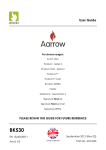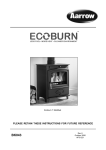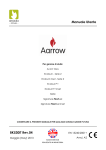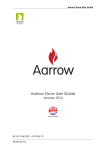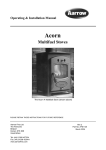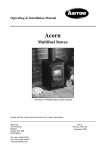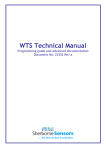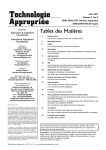Download Aarrow Fires Gas Stove Stove User Manual
Transcript
Installation / Servicing Instructions & User Manual Sherborne GSL Conventional Flue Gas Stove Sherbone GSL Natural Gas With Logs Shown PLEASE RETAIN THESE INSTRUCTIONS FOR FUTURE REFERENCE THIS STOVE IS NOT SUITABLE FOR TIMBER FRAMED PROPERTIES. Arada Ltd North Mills Industrial Estate, Bridport, Dorset, United Kingdom DT6 3BE Tel (+44) 01308 427234 Fax (+44) 01308 423441 www.arada.uk.com FOR USE IN COUNTRIES GB & IE Gas Council ID Number NG - 32-248-06 LPG - 32-248-07 Rev 3 Nov 2006 Part No. AFGS1095 CONTENTS SERVICING INSTALLATION Safety Notices General Information 3 3-4 Replacement Of The Glass Frame 25-26 Burner & Valve Assembly Removal 26 Annual Service 27 Cleaning Outer Surfaces 27 Fault Diagnosis 28 Annual Service Record 29 Contents List & Part Identification 5 Important Notices 6 Statutory Requirements 6 Certification 6 Technical Data 7 Gas Fire Dimensions 7 USER INSTRUCTIONS Installing The Stove 7 Lighting & Controlling The Fire Preparation of the stove 8 Cleaning Outer Surfaces Stove Location 8 Operation of Remote Control Shelf Clearances 9 Important Notices 38 32-33 33 34-37 Flue System 10 Statutory Requirements 38 Fitting The Flue Spigot And Blanking Plate 11 Certification 38 Shelf Clearances 39 Rear / Top Flue Options 11-12 Connecting The Gas Supply 13 Pressure Test Sequence 13 Fitting & Arranging The Coals 14-15 Fitting & Arranging The Logs NG 15-16 Fitting & Arranging The Logs LPG 16-17 Installation of Remote Control System 18-21 Commissioning The Stove Fire Testing Installation Check List 2 SPARE PARTS General Components 40-42 Options & Accessories 43 GUARANTEE 44 Final Factory Checklist 46 22 22-23 24 Aarrow Sherborne GSL CF INSTALLATION INSTRUCTIONS References in this manual to British Standards and Statutory Regulations and Requirements apply only to the United Kingdom. For Ireland the rules in force must be used. Before installation, check that the local distribution conditions, nature of the gas, pressure and the adjustment of the appliance are compatible. The manual is an important part of the appliance and must by law be handed to the end user on completion of the installation. SAFETY NOTICES • Do not attempt to burn rubbish or any other material in this appliance. • Do not use the appliance if the glass is cracked or broken. • Do not make any unauthorised modifications to the appliance. • It is recommended that the stove be guarded to protect the young and infirm using a fireguard complying with BS8423:2002. • Coal / Log set -The coal/log set contains Refractory Ceramic Fibres (R.C.F), which are man made vitreous silicate fibres. Excessive exposure to these materials may cause temporary irritation to the eyes, skin and respiratory tract. Care must be taken when handling these items to ensure the release of dust particles is kept to a minimum. To ensure that the release of fibre from these items is kept to a minimum, during installation and servicing it is recommended that a vacuum cleaner fitted with H.E.P.A. filters is used to remove any dust, soot or any other debris accumulated in and around the appliance. This should be performed before and after the installation. It is recommended that any replacement item(s) are not broken up but sealed within a heavy duty polythene bag and clearly labelled "R.C.F. waste". This is not classified as "hazardous waste" and may be disposed of at a tipping site licensed for the disposal of industrial waste. Protective clothing is not required when handling these items but it is recommended that gloves are worn and normal hygiene rules are followed. Always wash your hands before eating or Aarrow Sherborne GSL CF drinking. • In the event of a gas emergency, consult the telephone directory and ask for your local gas supplier. Guide to manual handling • Always obtain assistance when lifting the appliance. • When lifting always keep your back straight. Bend your legs not your back. • Avoid twisting at the waist. It is better to reposition your feet. • Avoid upper body/top heavy bending. Do not lean forwards or sideways when handling the fire. • Always grip with the palms of your hands. Do not use fingertips for support. • Always keep the stove as close to the body as possible. This will minimise the cantilever action. • Use gloves to provide additional grip. ________________________________________ GENERAL INFORMATION 1. General Note All materials and equipment used in the installation of this stove should be fit for the purpose, be of suitable quality and workmanship and should comply with the applicable British Standards, building regulations and rules in force. 2. Ventilation No purpose provided ventilation is normally required. 3. Flue Type The stove is suitable for flue options with a minimum diameter of 127mm (5”) and have a minimum effective height of 3 metres (10ft) see page 11 to 12. 4. Hazardous Materials Asbestos, hazardous or any banned materials have not been and will not be included in this product. 3 INSTALLATION INSTRUCTIONS 5. Stove location See installation instructions on page 7. 6. Packed details For packed weight see packaging labels. Please Observe Unpacking & Safety Warning Labels Stove Specification Label (Both Ends Of Box) Fig 1 7.Unpacking note When the stove is unpacked ensure no damage occurs if placed on the carpet as it can leave indentation marks. For contents list see page 5. 8. Fit for purpose All materials, appliances and equipment used should be fit for purpose, be of suitable quality and workmanship and should comply with the applicable British Standard. 9. Data Label Plate. The data label plate is fixed to the underside of the valve bracket assembly, and can simply be swung in and out as required (see Fig 2a). Please observe the data, safety and warning labels attached to this plate. Do not remove this plate from the stove. Fig 2a 4 Aarrow Sherborne GSL CF INSTALLATION INSTRUCTIONS CONTENTS LIST ALL TYPES Main Box Packed Inside Stove STOVE ENGINE • Coal Set (NG & LPG) or • GLASS FRAME ASSEMBLY • Log Set (NG Only) or • DUMMY FUEL RETAINER • Log Set (LPG Only) • OPERATING INSTRUCTIONS • CANOPY COVER PLATE • CANOPY INFILL PIECE • HOT PLATE (BLANKING) • FLUE SPIGOT • OUTER BODY & CANOPY • FIRE DOORS • VALVE COVER • Flue Spigot Hot Plate (Blanking) Operating Tool OPERATING TOOL • GAS SERVICE TAP & GLASS SCREWS • PART IDENTIFICATION Canopy Cover Plate Outer Body & Canopy Canopy Infill Piece Stove Engine Assembly Glass Frame Assembly Fire Doors Dummy Fuel Retainer Valve Cover Fig 2b Aarrow Sherborne GSL CF 5 INSTALLATION INSTRUCTIONS IMPORTANT NOTICES STATUTORY REQUIREMENTS A qualified gas engineer must carry out the installation and servicing of this appliance in accordance with these instructions and in compliance with current Building Regulations. Such person must be a registered CORGI engineer. This appliance is designed to run on natural gas (NG) or liquid petrolum gas (LPG) depending up on the model purchased. Warning - Only use the appliance with the specified gas. The instructions must be read before use of the appliance. This product must be installed in accordance with the rules in force. Please note the following; Detailed recommendations are outlined in the current issue of the following British Standards:BS5440 parts 1 and 2, BS5871 part 1 and BS6891. • Sealed components must not be interfered with. • Servicing instructions and part identification numbers are given towards the back of the manual. • Only use genuine Aarrow parts for replacements. • Ventilation, no purpose built ventilation is normally required, normal adventitious room ventilation being suffient. • Coal / log set, see safety notice on page 3 must be observed. All surfaces except the control knobs are considered to be working surfaces. The current Gas Safety (Installation and Use) Regulations (as amended). The Building Regulations for England and Wales 2000 ref Approved Document J 2002 edition (issued by the DTLR). The Building Standards (Scotland) (Consolidation) Regulations. Any Manufacturer's Instructions must not be taken as overriding statutory requirements. _________________________________________ CERTIFICATION This appliance is CE certificated for performance and safety. Therefore, it is important that no alteration is made to the appliance. Any alteration not approved by Arada Ltd will invalidate the guarantee. Warning: Under no circumstances must the fire be operated if the glass is cracked or broken. Warning: If operational appliance, it investigated engineer. it is known or suspected that an or ignition fault exists on the must not be used until it has been and corrected by a qualified gas Warning: THIS GAS APPLIANCE MUST BE SERVICED EVERY TWELVE MONTHS BY A QUALIFIED GAS ENGINEER. 6 Aarrow Sherborne GSL CF INSTALLATION INSTRUCTIONS TECHNICAL DATA Natural Gas LPG Gas Category I2H I3P Supply Pressure 20mbar 37mbar Bray 82/400 Bray 82/160 Heat Input (gross) 6.1 kW 5.7kW Gas Rate 0.55m3/hour 0.21m3/hour Gas Type Injector Max. Heat Setting Min. Heat Setting Heat Input (gross) 2.5 kW 2.5kW Gas Rate 0.23m3/hour 0.09m3/hour Efficiency Class CLASS 2 CLASS 2 NOx Class Unclassified Unclassified Country Of Use AT,DK,ES,FI, GB,GR,IE,IT, NO,PT,SE ES,FR,GB, GR,IE,IT,PT Gas Council Id Number 32-248-06 32-248-07 Table 1 Aarrow Sherborne GSL CF Fig. 3 INSTALLING THE STOVE A CORGI qualified gas engineer MUST install the stove in accordance with the following regulations and standards:The Gas Safety (Installation and Use) Regulations current edition. The Building Regulations for England and Wales 2000 ref; Approved Document J 2002 edition (issued by the DTLR). The Building Standards (Scotland) (Consolidation) Regulations. BS5440 parts 1 and 2 BS5871 And these Installation Instructions. Warning: Failure to comply with the regulations, requirements, or these instructions will invalidate the guarantee and could have hazardous consequences. IMPORTANT Please note that in tight recesses the gas supply point may be inaccessible. Therefore it may be necessary to route the pipe for the gas supply before installing the stove into its recess. 7 INSTALLATION INSTRUCTIONS PREPARATION OF THE STOVE Prior to starting the installation and after removing the packaging, check that all the parts have been supplied to the contents list on page 5. Carry out the following:Step 1 Remove outer casing (disengage locking levers see page 25, steps 1a /b, 2, 3, 4, and 5). Step 2 Remove glass and retaining frame (see page 25 step 6). Step 3 Remove the packaging from the coal / log set and cut the cable tie retaining 8mm olive and valve connection nut (located to the rear of valve assembly). The stove must not be installed against a combustible wall. The stove must never be positioned closer than 100mm to any rear wall see Fig. 4a The stove is NOT suitable for houses with timber frame construction. STOVE LOCATION The appliance must not be installed in a room or space, which contains a bath or shower. This stove is designed for use with either top or rear flue outlets and must be mounted on a hearth. The hearth must be strong enough to support the stove. For overall minimum hearth sizes see Fig.4a and Fig.4b. To comply with current Building Regulations the stove must stand on a fireproof hearth which has a minimum upper fireproof layer of 12mm non-combustible material. The rear of the stove is to be 100mm from the wall which must be of a non-combustible material. The hearth must not be capable of inadvertent covering by a carpet or rug. This should be achieved by either: •The hearth being 50mm above the level of the room floor. or •a 50mm high fender or kerb being fixed around the edge of the hearth. Ensure the hearth is level and flat. Do not place any combustible material including clothing, furniture and furnishings (including curtains) within 1 metre of the stove. For details of combustible and non-combustible shelf clearances see graphs 1 and 2 on page 9. The rear edge of the canopy cover must be fitted flush against the wall. It is acceptable to place the stove against plaster board on dry line property. 8 X=100mm Minimum Distance Y=See Graph 1 & 2 Fig. 4a Side Clearances A=100mm Minimum Per Side To A Non Combustible Wall. B=200mm Minimum Per Side To A Combustible Wall. Fig. 4b Aarrow Sherborne GSL CF INSTALLATION INSTRUCTIONS SHELF CLEARANCES Combustible shelf clearances The minimum height from the extreme top surface of the stove to the underside of a shelf or other projection made of wood or any other combustible material is shown on graph 1. Graph 1 Non-Combustible shelf clearances The minimum height from the extreme top surface of the stove to the underside of a shelf or other projection made of non-combustible material is shown on graph 2. Graph 2 WARNING: No shelf is to be used with a top flued appliance, where it has to pass through a shelf. Aarrow Sherborne GSL CF 9 INSTALLATION INSTRUCTIONS FLUE SYSTEM The stove must be connected to a suitable and efficient flue that provides a good updraught to safely take the products of combustion (fumes) from the stove outlet to the outside air. To ensure a good updraught it is important that the flue gases are kept warm and that the flue size suits the stove. The termination of the outlet at the top of the flue also needs to comply with the Building Regulations. The minimum effective height of the chimney must be at least 3 metres and when warm the flue draught should be between 0.05 and 6mb (0.5mm to 6mm water gauge). The stove requires a minimum flue size of 125mm (5 inches). The stove can be fitted to a sound conventional solid fuel burning chimney system (Class 1) provided it is swept. The flue must be terminated with a suitable chimney pot or cowl and the chimney or flue shall be swept prior to installation unless the chimney is clean and unobstructed. The flue and chimney installation must be carefully checked by a competent person before fitting the stove to ensure it is suitable and will work safely. The flue must also pass a Flue flow test (smoke test) to BS 5440: Part 1. For advice on flues and chimneys contact; NACE (National Association of Chimney Engineer): telephone 0800 0924019 www.nace.org.uk or NACS (National Association of Chimney Sweeps): telephone 01785 811732 www.chimneyworks.co.uk If the chimney is not sound or the chimney has an internal flue size greater than 225mm (9 inches) diameter or 200 x 200mm square, a 125mm (5 inches) diameter stainless steel flexible flue liner complying with BS 715 should be installed in the flue. If a new chimney is being provided it should fully comply with the relevant Building Regulation Requirements and BS 5440: Part 1. Suitable types of chimney include the following. • Masonry chimney built with clay or concrete liners, or a chimney block system meeting Building Regulations. • Precast concrete gas flue block complying with BS 1289: Part 1 Factory made metal chimney complying with BS 715 (often called "Twin wall Class 2 chimney") or Factory made metal insulated chimney complying with BS 4543: Part 2 (often called "Class 1 prefabricated metal chimney"). To ensure the flue gases are kept warm an insulated chimney system should be used if the chimney is positioned outside the building. 10 Aarrow Sherborne GSL CF INSTALLATION INSTRUCTIONS FITTING THE FLUE SPIGOT AND BLANKING PLATE Note: Blanking plate fitted to top flue outlet for packing The gas stove is designed so that the flue can be fitted to either the top or the rear of the appliance. Fit the flue spigot and blanking plate for either top or rear flue outlet in accordance with figure 5a or 5b (below). for checking for debris build up. Closure plates must be sealed to the chimney or fireplace opening with fire cement, fireproof rope or other suitable high temperature mastic. REAR FLUE OPTIONS Open Hearth (See Figure 6-a page 12) Fit and seal a ‘T’ section (with debris /soot collector) directly into the flue spigot. Ensure it passes through the closure plate by at least 102mm (4”). The maximum horizontal section allowed is 350mm. Provide a minimum vertical height of 600mm of flue from the height of the rear flue outlet. Closure Plate (See Figure 6b page 12) Fig. 5b Fig. 5a Lock the blanking hot plate in place by rotating anti-clockwise and tighten by tapping gently with a block of wood and mallet. Fit the spigot to the unused opening in the same way. The units are sealed by the attached gaskets. Connect the flue spigot to the rear outlet then connect a flue extension to the spigot up to a maximum length of 350mm. Fit and seal the closure plate into the fireplace opening. Position the stove so the flue extension passes through the hole in the closure plate by at least 50mm. Ensure all joints are sealed with fire cement or a suitable high temperature sealant. TOP FLUE OPTIONS Top Flue (See Figure 6c page 12) Provide a minimum vertical height of 600mm of flue measured from the top of the appliance. Position the stove, with flue spigot in place, into position under the flue and seal the spigot/flue connection with fire cement or a suitable high temperature sealant. Fig 5c CLOSURE PLATES It is recommended that a smoke test is performed inside the stove to ensure that adequate flue draw is evident after making the flue connection If a closure plate is used for sealing off the chimney or fireplace opening it can be made of metal (e.g. aluminium sheet) or fireplace board (see figure 6 a/b/c on page 12) however provision must be made Aarrow Sherborne GSL CF 11 INSTALLATION INSTRUCTIONS Y=See Graph 1 Fig. 6c. Fig. 6a Fig. 6b 12 Aarrow Sherborne GSL CF INSTALLATION INSTRUCTIONS CONNECTING THE GAS SUPPLY Once the stove is in place it is then possible to connect the gas supply. The gas supply point is located centrally at the rear (as show in fig.7) and should be connected in accordance with the following requirements. Gas Inlet Rear Of Valve Fig. 8 PRESSURE TEST SEQUENCE Controls are located at the base of the stove below the ash lip. Fig. 7 Check that the appliance is suitable for the gas supply; refer to data labels on packaging and/or the stove data label for the gas type. The gas installation must be in accordance with the current issue of BS6891.Gas supply pressure at the fire should be 20mbar for natural gas & 37mbar for LPG. The gas supply should be connected with the 12mm fitting and olive supplied with the stove. A maximum pipe run of 1.5 meters (or 5 feet) should be adhered to. Copper tubing may be used provided a distance of 25mm is maintained between pipe-work and any surface of the stove. The gas service tap (supplied) should be fitted adjacent to the fireplace to enable safe removal of the appliance for servicing. After fitting the supply, operate the gas tap (supplied) and check all joints up to the termination of the supply pipe for gas tightness using a soap/water solution and the pressure drop method. To check the pressure to the burner. This must be carried out with all other gas appliances operating at maximum. To check the pressure to the burner it is necessary to ignite the appliance and set to 'high rate'. (See pressure test sequence). Aarrow Sherborne GSL CF Ensure supply is isolated and the valve is in the off position Step 1. Remove the valve control cover by unscrewing the pozi screw located by knob B and lever the retaining tab to the side of knob A. Step 2. Locate the outlet pressure tap and unscrew approximately half a turn anti-clockwise with a small flat bladed screw driver. Connect a pressure guage to the outlet pressure tap. Step 3. Re-connect the supply and light stove. (see lighting and controlling the stove section in the users instructions section of this manual). Turn to high setting. Read pressure guage, setting to be 20 mbar for Natural Gas or 37 mbar for LPG Step 4. If any adjustment is required, use the brass screw located between knob B and knob A on the front of the valve, and adjust accordingly to the indication symbol marked upon the valve body. Step 5. Turn off stove and isolate the supply. Step 6. Disconnect manometer and re-tighten the outlet pressure tap screw. Do not over tighten. Step 7 Replace the valve control cover. 13 INSTALLATION INSTRUCTIONS FITTING AND ARRANGING THE COALS (Both NG & LPG versions) Centre Coal Position Pilot Notch Ensure the appliance is cold Safety Notice - Please see SAFETY NOTICES ref. Coal / Log sets page 3. Warning: The coals and the coal matrix are fragile ensure they are handled carefully. Ensure location is correct. Do not force the matrix into position. If the coals and/or the coal matrix are damaged they must be replaced with genuine Aarrow parts. Warning: An incorrect coal layout may cause soot to build up inside the stove and therefore invalidate the guarantee. Fig. 10a 3) Now position one of the loose coals into the centre of the stove ensuring that it is placed into the centre cutout and when in position, this coal will be resting upon the four corners of the base matrices. See Fig. 10a & b. RR LR RF LF Fig. 10b 11X LOOSE COALS Fig. 9 How to arrange the coals (see Fig 9 for part identification) Plan View Of Base Matricies - White Dots Indicate Loose Coal Positions / Cut outs. 4) Next, take 6x coals and place along the front row of the base matrices, 3x to the left of the centre coal and 3x to the right of the centre coal. Observre the cutout positions within the matices as shown in Fig. 10b & 10c. 1) Place the 2x larger base matrices at the rear of the burner. These are labelled LR (left rear) & RR (right rear). These should be positioned so that the slots in the matrices sit over the rear upright fold of the burner top plate. 2) Next position the 2x smaller base matrices between the rear matrices and the front of the firebox. These matrices are labelled, LF (left front) & RF (right front). The RF matrix has a notch in the front to avoid the pilot assembly. The arrangement should look like Fig 10a. 14 Fig. 10c 5) Take the remaining 4x coals and place along the upper edge to the base matrices. Again, place the coals into the areas shown in Fig 10b. The coal set layout is now complete and should look like Fig 10d & 10e. Aarrow Sherborne GSL CF INSTALLATION INSTRUCTIONS Key For Contents To NG Log Set A = Rear log matrix (black in colour) B = Loose Embers (bagged) C = Curved Log D = Y Shape Log E = Central Log (Knotted Lump Protruding) F = 3x Small Twigs G = 1x Large Twig Fig. 10d How to arrange the logs 1) Position the rear log matrix in the centre at the rear of the burner. The base of the matrix should slot down behind the burner. See Fig. 12a. Fig. 10e Plan View Of Coal Set Layout. Note - Ensure that the pilot light is visible through the slot in the front right base matrix and that the pilot flame is not impinged. FITTING AND ARRANGING THE LOGS (NG ONLY) Ensure the appliance is cold Safety Notice - Please see SAFETY NOTICES ref. Coal / Log set, page 3. Warning: The logs and matrix are fragile, ensure they are handled carefully. Ensure location is correct. Do not force the matrix into position. If any of the logs and/or rear matrix is damaged, they must be replaced with genuine Aarrow parts. Warning: An incorrect log layout may cause soot to build up inside the stove and therefore invalidate the guarantee. A 2) Lay the Y shape log to the right hand side of the burner. Ensure that the Y open section is upper most and is resting onto the cutout flat area to the right of the rear log matrix. The base should be approimately 30mm from the front of the stove window opening. See Fig 12a. 3) Take the curved log and place this to the left hand side of the burner. Make sure that the base of this log is again approx. 30mm from the front of the stove and the upper end of the log is resting on the grooved notch within the rear log matrix. See Fig 12a. Note, there should be a gap between both side logs when resting correctly on the rear matrix. 4) Next scatter the loose embers onto the burner area. Take care not to obstruct the pilot assembly. B Fig. 12a C F E Fig. 11 Aarrow Sherborne GSL CF G D 5) Lay the central log, from the centre front of the burner to the rear of the stove. Sitting the upper portion of the central log onto the edge of the 15 INSTALLATION INSTRUCTIONS upper corner of the curved left hand log. See Fig. 12b. Note, the top resting position of the central log is angled to the left. FITTING AND ARRANGING THE LOGS (LPG ONLY) Ensure the appliance is cold Fig. 12b 6) Place 2x smaller twigs as shown in Fig. 12b. Note, the bottom of the twigs rest between the stove body and burner. Take care with the right hand twig to avoid impinging upon the pilot assembly. 7) Take the remaining small twig and large twig and place as shown in Fig 12c. The log layout is now correct. Safety Notice - Please see SAFETY NOTICES ref. Coal / Log set, page 3. Warning: The logs and matrix are fragile, ensure they are handled carefully. Ensure location is correct. Do not force the matrix into position. If any of the logs and/or rear matrix is damaged, they must be replaced with genuine Aarrow parts. Warning: An incorrect log layout may cause soot to build up inside the stove and therefore invalidate the guarantee. D B A C F G E Fig 13 Fig. 12c Key For Contents To LPG Log Set A = Y Shaped Rear Log B = Loose Embers C = Curved Log D = Straight Log E = 1x Medium Twig F = 3x Small Twig G = 2x Large Twigs How to arrange the logs 1) Position the Y shaped log across the rear of the burner, standing up against the rear of the firebox and behind the burner. See Fig. 14a. 2) Scatter the loose embers over the burner, taking care not to cover the pilot assembly. See Fig. 14a. 16 Aarrow Sherborne GSL CF INSTALLATION INSTRUCTIONS 5) The remaining 3X small twigs are placed as shown in Fig. 14d. The LPG log layout is now complete. Fig. 14a 3) Place the curved log to the left hand side of the firebox, rest the top of this log onto the top of the Y shaped open end of the rear log. Take the straight log and position this to the right hand side of the firebox, again rest the rear of this log onto the rear Y shaped log, opposite end to the curved log. Note, rest both fronts of these end logs against the front corners of the burner.See Fig.14b. Fig. 14d Fig. 14b 4) Next place the 2x large twigs into the layout with the base of each twig central about the stove opening and placed to the front of the stove. The tops of these twigs radiate out from the base to form a vee shape and rest upon the rear Y log (left hand) and straight log (right hand). The medium twig is placed between the large twigs as shown in Fig. 14c. Fig. 14c Aarrow Sherborne GSL CF 17 INSTALLATION INSTRUCTIONS NOTE: If the optional remote control system has been ordered with the stove and is not fitted please proceed. FOR A MANUAL STOVE (WITHOUT REMOTE CONTROL) PROCEED TO PAGE 22. INSTALLATION OF REMOTE CONTROL SYSTEM Important • A corgi registered gas engineer must carry out the installation of the remote control system PARTS LIST 1 2 3 4 5 6 Motor Ultrasonic Receiver Remote control handset Wiring Harness (Multiblock end to reciever, spade connections to motor/micro switch) Micro-switch AA/LR6 1.5v Batteries (4x) & 9V-6F22 9v Battery (1) Supplied (Not Shown) 4 1 2 5 3 Fig. 15 Technical data Ambient temperature range Remote and receiver max. 140deg F / 60deg C Connecting cable max. 356deg F / 180deg C Batteries Quality Alkaline Handset: 1x9V Block Receiver: 4x1.5V AA 18 Aarrow Sherborne GSL CF INSTALLATION INSTRUCTIONS ASSEMBLE MOTOR 1) Remove the front cover from the valve. This is done by unscrewing the small pozi screw, located by knob B. Unclip the right hand side of the cover located to the side of knob A. See Fig. 16a & b. Tab Screw Knob B Knob A Fig. 16a Fig. 16b 2) Remove the cover and dispose of the spacer tube fitted with the screw. 3) Position the motor onto the location lugs (arrow X) and engage the drive gear onto knob B (arrow Y). X Y Fig. 16c Fig. 16d 4) Replace valve cover, ensure clip is located before the pozi screw is tightened. Do not over-tighten the screw as this may effect the operation of the control. 5) Take the micro switch and fix to the front of the valve cover with the self tapping screw provided. Switch is located onto the lug moulded within the valve cover, next to knob B. See Fig. 16e. Wiring Connections Knob B Micro Switch Fig. 16e Aarrow Sherborne GSL CF 19 INSTALLATION INSTRUCTIONS ASSEMBLE RECEIVER Important The remote system is intended for use with original Aarrow parts only. 1) Carefully push the multi block connector on to the connection within the reciever unit as shown in Fig 17a. This connector can only fit one way, so ensure the slot in the recievers board lines up with the moulding within the multi block connection. SLOT Fig. 17a Fig. 17b 2) Next, connect the angled spade connectors to the motor, note there are two different sized connectors and these can only be fitted to the appropriate sized spade tab. The remaining narrow spade connectors fit to the spade tabs on the micro switch. These are not handed, see Fig. 17b. 3) Place the double sided adhesive tape to the underside of the reciever unit. Slide back the cover and insert the 4x AA/LR6 1.5v batteries into unit, observing the correct polartity as marked on the unit. Re-place cover. Fig. 17c. CAUTION! Ensure the batteries are inserted AFTER the motor is wired. A short circuit can destroy the electrical components. 4) Position the reciever unit, as shown in Fig. 17d onto the space provided on the valve bracket. Affix the underside of the unit with the double sided tape. Take care to route the wiring harness away from any hot parts and do not obstruct the valve controls. The reciever unit works by ultrasonic so ensure that the recieving round grill is facing to the front of the stove. Fig. 17d Fig. 17c 20 Aarrow Sherborne GSL CF INSTALLATION INSTRUCTIONS HANDSET 1) Insert the battery (9v) into Remote control. Slide back the battery compartment cover, insert and connect a suitable battery and replace the cover. Fig. 18 2) The remote is now ready to use. In the event of battery failure the flame height can still be adjusted manually using the knob B on the valve. NOTE Please note, the placement of the Remote control (temperature sensor) is important to assure proper temperature regulation. Please refer to user instructions. Aarrow Sherborne GSL CF 21 INSTALLATION INSTRUCTIONS COMMISSIONING THE STOVE Refit the glass/glass frame assembly. Refit the outer body and secure with the locking levers. If horizontal flue is used fit the canopy cover plate. (See page 25 step 1a.) If top flue is used locate the infill plate (See page 25 step 1b). Follow the lighting instructions (See pages 32 & 33), light the pilot and check:1. The operation of the control 2. The cross lighting of the burner 3. All gas settings can be achieved Repeated operation of the spillage monitoring system whereby the OSD (oxygen sensing device/spillage monitoring system). If their is a problem with the ODS pilot going out after the stove has operated satisfactory, this indicates a possible flue draw problem. Seek expert advise from a qualified engineer. Warning: The spillage monitoring system, consists of a special oxygen sensing device (OSD) pilot and is a safety feature required by law. It must not be adjusted or put out of action by the installer. If the spillage monitoring system or any of its parts are to be replaced, only original manufacturers parts must be used. FIRE TESTING Flame failure device testing Step 1 Ignite the appliance in accordance with page and run for 60 seconds. Step 2 Turn the appliance off to extinguish the pilot, listen for a snap at the control valve. This should occur within 60 seconds of the pilot flame being extinguished. The snap sound will be the magnet disengaging, and thus shutting off the flow of gas to the pilot and burner. Spillage Test Step 1. Close all doors and windows. Step 2 Light the appliance and set to the high rate. Step 3. Allow fire to warm up for 10 minutes. Step 4. Position the smoke match at the back of the fire centrally beneath the rear diverter as shown in Fig 19a. Fig. 19a Note: The fire will give off non-toxic fumes when first used. This is perfectly normal it will disappear after the first few hours. Once the spillage test is complete open windows and doors to ventilate the area. SELF LEVELING REAR FEET Once the stove is in position on the hearth, working on the rear legs, simply loosen the pozi screw and rotate the inner ‘pear’ shaped adjuster to touch the hearth. Re-tighten the screw and repeat for the other side. All of the smoke should be drawn into the fire. If this does not occur the appliance must be disconnected and the flue checked. Step 5. If there is an extractor fan in any room, this must be turned on and any doors between it and the fire left open, repeat the spillage test. 22 Fig. 19b Aarrow Sherborne GSL CF INSTALLATION INSTRUCTIONS Advise the end user 1. That there will be an odour from the stove when the stove is first lit and is non-toxic. It is advised that the stove is initially run with the room well ventilated to disperse the fumes. 2. How the valve controls operate and how to light the pilot. 3. Advise about leaving pilot on. 4. That the stove is fitted with two safety devices, one cuts off the stove if for any reason the gas supply is turned off - A flame failure devise. The second will cut the stove off if there is inadequate flue draw for example a blockage in the chimney. If this occurs the stove should not be re-lit until the stove and flue have been checked by a qualified gas engineer. 5. To read the users instructions before using the stove. 6. The stove must never be used if the glass is cracked or broken. 7. Explain that the working surfaces of the stove will get hot and that no combustible materials including clothing, furniture and furnishings (including curtains) must not be placed within one metre of the stove. Leave the instruction manual with the end user Aarrow Sherborne GSL CF 23 INSTALLATION INSTRUCTIONS CHECKLIST Hearths, Fireplaces, Flues and chimneys This checklist is to ensure hearths, fireplaces, flues and chimneys are satisfactory, and to show what you have done to comply with the requirements of The Building Regulations 2000 Approved Document J 2002. 1. Building address, where work has been carried out....................................................................................................................................... ......................................................................................................................................................................................................................... 2. Identification of hearth, fireplace chimney or flue 3. Firing capability: solid fuel/gas/. 4. Intended type of appliance. State model and output. 5. Ventilation provisions for the appliance: State type and area of permanently open vents. 6. Chimney or flue construction a) State the type or make and whether new or existing. b) internal flue size (and equivalent height, where calculated - natural draught gas appliances only). c) If clay or concrete flue liners used confirm that they are correctly jointed with socket end uppermost and state jointing materials used. d) If an existing chimney has been refurbished with a new liner, type or make of liner fitted. e) Details of flue outlet terminal and diagram reference. Outlet Details: Complies with: f) Number and angle of bends. g) Provision for cleaning and recommended frequency. 7. Hearth. Form of construction. New or existing? 8. Inspection and testing after completion Tests carried out by: Tests and results Flue inspection visual sweeping coring ball smoke Appliance (where included) spillage I/we the undersigned confirm that the above details are correct. In my opinion, these works comply with the relevant requirements in Part J of Schedule 1 to the Building regulations. Print name and title....................................................................................................Profession.......................................................................... Capacity......................................................................................................................Telephone.......................................................................... Address............................................................................................................................................................Postcode....................................... Signed........................................................................................................Date................................. Registered membership of..(e.g. CORGI, OFTEC, HETAS, NACE, NACS)............................................ 24 Aarrow Sherborne GSL CF SERVICING REPLACEMENT OF THE GLASS Step 4 Lift the body and canopy off the chassis. Refer to “guide to manual handling” on page 3. IMPORTANT When refitting the glass frame ensure the original screws are used. Longer screws may foul the coal / log set placement. Ensure the appliance is cold. Step 1a For rear flue appliance remove canopy cover plate. Step 5 Remove dummy fuel retainer (2 screws) If glass is broken, suitable gloves must be worn for protection. Step 1b For top flue appliance remove infill piece. Step 2 Remove the fire doors Open and lift off hinges (held shut by magnet). Step 6 Remove glass and glass frame. • Remove any loose glass • Be aware of any glass that will become loose when removing the frame. •Loosen but do not remove the four screws at the base of the frame. •Remove all but one of the top centre retaining screws. Step 3 Disengage locking levers, one per side. •Remove the remaining top screw. The frame and glass will now be loose and can be removed. •The frame has slots at the base to ease removal. •Remove any remaining loose glass. Aarrow Sherborne GSL CF 25 SERVICING Step 7 Clear inside of stove of any debris. Step 7 Remove the two self tapping screws each side of the injector as shown below. Step 8 To re-assemble reverse this procedure. See initial note on page 25. Note:When relocating the body and canopy assembly ensure the front location tab is engaged in the chassis. The burner assembly may now be removed. Slide back off the injector and lift the burner assembly upwards from the rear while at the same time pivoting it towards you. Take care not to damage the injector. BURNER AND VALVE ASSEMBLY REMOVAL Please note! When handling the burner assembly be aware of the sharp points of the self tapping screws on the underside Ensure the appliance is cold. Step 1 Isolate the gas supply from the stove Step 2 Disconnect the supply inlet pipe by releasing the pipe nut at the rear of the valve, see page 13. Step 8 To remove the valve assembly undo the 3x Pozi M5 screws, located within the fire box (2x to the front of the burner and 1x centrually to the rear of the burner), lift upwards from the rear while at the same time pivoting it towards you. Carefully guide the controls through aperture clear of the stove. After replacement of burner assembly, ensure that a check on the gas tightness of any new joint is carried out. Step 3 Remove the outer body of the stove (Ref Page 25). Step 4 Remove the dummy fuel retainer and then the glass frame assembly (Ref Page 25). Step 5 Remove the coals or logs. Step 6 Remove the base coal matrix (four pieces) Take care not to damage the matrix, (Page 14). 26 Aarrow Sherborne GSL CF SERVICING ANNUAL SERVICE THIS GAS APPLIANCE MUST BE SERVICED EVERY TWELVE MONTHS BY A QUALIFIED GAS ENGINEER. See "SAFETY NOTICES" ref coal set page 3. Ensure the appliance is cold. Step 1 Isolate the gas supply from the stove. Step 2 Remove the outer body of the stove. Step 3 Remove the glass. Important: If the glass is broken or cracked or the glass gasket is damaged they must be replaced before the stove is used. Step 4 Carefully remove and clean the loose coal / logs set of any soot deposits using a soft brush. Step 5 Clean the firebox of any soot deposits using a soft brush. Step 6 Carefully lift out and clean the base coal matrix. Important: If any of the ceramic components are damaged they must be replaced with original Aarrow parts. Step 7 Clean the burner top and surrounding areas with a vacuum cleaner.(See safety notices on page 3). Step 8 Inspect the pilot assembly to ensure that it is clean, unobstructed and in good work ing order. Step 9 Looking into the flue from inside the stove check that it is clear of any debris or obstructions. Step 10 Check the system for gas soundness. Step 11 Check the ignition of the pilot and with the pilot turned off check that the flame failure system is working. Step 12 Relocate the base coal matrix (4x piece). Step 13 Relocate and position the loose coals or re-assembly the log set. Step 14 Light the pilot and check the operation of the stove and the flame picture. Step 15 Relocate the glass frame assembly, ensuring all the screws are replaced and secure. (Use original screws only.) Aarrow Sherborne GSL CF Step 16 Refit the dummy fuel retainer.(2x screws) Step 17 Relocate the outer body of the stove. Step 18 If the stove is rear flued proceed to fit the top flue cover plate into the canopy cutout ensuring the front tab is located under the canopy (see page 25, step 1a). Place the valve cover in front of the control valve. Step 19 If the stove is top flued, proceed to fit the top flue infill piece (see page 25, step 1b). Place the valve cover in front of the control valve. CLEANING OUTER SURFACES It is best cleaned using a soft brush. Do not allow moisture to remain on the top while cold or surface rust may occur. 27 SERVICING FAULT DIAGNOSIS START Does the pilot ignite? Does the pilot stay alight? Yes Yes Does the main burner light? Does the stove stay alight? Yes Yes Fire satisfactory Is the gas supply turned on? Is their air in the system? No Yes Is the main injector blocked? Purge system Yes Is the supply pressure correct? No Turn gas on Is the thermocouple o.k.? No Correct pressure Is their a spark at the No electrode? Yes Check if gas is passing from control valve. Yes No No No Clean and replace as necessary Check gas supply and operation of control valve. Replace if necessary. No Is pilot flame the correct size & playing onto thermocouple Yes Check for spark output from control valve. Yes Investigate for blocked chimney and adaquate ventilation check spillage. If their is no obvious blockage, seek expert advise. Replace pilot assembly OSD Yes Yes No No No No No Confirm supply pressure is correct Replace the pilot OSD assembly Replace pilot OSD assembly Replace control valve OSD PILOT Oxygen Sensing Device Pilot Investigate control valve operation and replace if necessary. Replace pilot OSD assembly 28 Aarrow Sherborne GSL CF ANNUAL SERVICE RECORD Date of Visit Company Work Carried Out Signature Should you have any questions about your Sherborne GSL Gas Stove that is not covered in this manual please contact your Aarrow stove retailer. Please keep all repair receipts safely. Please ensure you have this manual available when an engineer visits as they will complete the service record chart. Aarrow Sherborne GSL CF 29 ADDITIONAL NOTES 30 Aarrow Sherborne GSL CF USER INSTRUCTIONS Aarrow Sherborne GSL CF 31 USER INSTRUCTIONS LIGHTING THE FIRE & CONTROLLING Under no circumstances must the stove be operated if the glass is cracked or broken. It is recommended that if the property is occupied the pilot be left on permanently. This will keep the stove and its components, including the ceramic coal / log set in a warmer state and assist the lighting of the burner. This in turn will reduce the chance of condensation and any associated problems. If the property is left unoccupied for a long period of time the pilot must be switched off. The controls are located beneath the ash lip at the base of the appliance. (See Fig.20a) Note: Ensure burner control knob “B” is set at maximum and pilot control knob “A” is set in the off position. (See Fig. 20e) Fig. 20a Step 1. To ignite the pilot. First locate the pilot, it can be viewed in the front right hand side of the coal / log bed. Open doors and look downward through the glass window 50mm from the right hand side. To ignite the pilot turn control knob “A” anti-clockwise towards the spark position (See Fig. 20b) until it stops, press down and hold in for 5 seconds. (only pilot gas flows) . Continue pressing down while turning knob “A” anti-clockwise to the small flame position, this will activate the piezo and light the pilot. Continue to hold down for a further 10 seconds after pilot has been lit, if the pilot does not stay lit repeat the procedure. When the pilot stays lit release knob “A” at the small flame position. (See Fig. 20c). B A Fig. 20c NOTE! This lighting procedure does not have to be carried out every time the stove is used provided the pilot is left alight. Step 2. To ignite burner With the pilot lit turn control knob “A” to the large flame position and release. This will ignite the burner. (See Fig. 20d) On initial lighting or after a period of non use, there may be a short delay of 5 or 6 seconds to allow the burner chamber to fill with gas, before ignition takes place, this is perfectly normal. To achieve the desired setting turn knob “B” to suit. Turn anti-clockwise to increase input and clockwise to decrease input. Max Min Fig. 20d NOTE! Between the Max and Min burner settings an infinitely vairable flame height is achievable. B A Fig. 20b 32 NOTE! Condensation may form on the glass panel during initial ignition of the burner, this is normal and due to the moisture in the atmosphere. This will disappear within 10 minutes of firing. Aarrow Sherborne GSL CF USER INSTRUCTIONS Step 3. To turn the stove and the pilot off completely, turn control knob “A” to the small flame setting, (pilot frame) depress and turn to off position, then release (See Fig. 20e) CLEANING OUTER SURFACES It is best cleaned using a soft brush. Do not allow moisture to remain on the stove while cold or surface rust may occur. A B Fig. 20e Important, when control knob “A” is turned to the off position a built-in safety lock is activated which will prevent you from turning the control knob for 60 seconds. Do not try to force the control, wait the 60 seconds. NOTE! If the pilot flame is extinguished either intentionally or unintentionally, no attempt to relight the gas should be until at least 3 minutes has elapsed. NOTE! During the initial firing, the stove will give off non-toxic fumes when first used. This is perfectly normal and will disappear after the first few hours. It is advised to ventilate the room by opening doors and windows to prevent irritation to to user. NOTE! The fire doors can be opened during operation, for a greater viewing area to the flame picture, this does not effect the operational performance of the stove. NOTE! During operation, the metal surface of the stove will be HOT, a operating tool is supplied with the stove and can be used to open the doors if required. See fig. 20f. Fig. 20f Aarrow Sherborne GSL CF 33 USER INSTRUCTIONS NOTE: ONLY FOR STOVES WITH REMOTE CONTROL SYSTEM TEMPERATURE DISPLAY REMOTE CONTROL Display A Auto Timer B Fig. 21 When the pilot has been lit, the remote transmitter can be used to control the flame height or to turn the main burner on or off. Aim the remote transmitter at the control valve and press the top button 'A' to increase the input or the bottom button 'B' to decrease the input. Short tapping of either button allows incremental change in flame height. Note! In the event of battery failure the flame height can still be adjusted manually Caution! It is recommended to turn the combination control either to the off or pilot position if the appliance is left unattended for long periods (e.g vacation) so that it cannot receive commands from the remote transmitter. Exercise caution when leaving the appliance unattended, and in exceptional cases sound waves from sources other than the transmitter can cause changes in flame height adjustment. 34 Aarrow Sherborne GSL CF USER INSTRUCTIONS THERMOSTAT AND TIMER REMOTE CONTROL TRANSMITTER FUNCTIONS Set the display (from *C/24 h to *F/12 h and vice versa) • After connecting the battery or by simultaneously pressing AUTO and TIMER, the display flashes you are in set mode. • From set mode, press AUTO to switch from *F (and 12 hour clock) to *C (and 24 hour clock) • The display will automatically return to manual mode after some time, but you may immediately return ual by depressing the TIMER button. Set the current time • After connecting the battery or by simultaneously pressing AUTO and TIMER, the display flashes you are in set mode. • From set mode, press ( A ) to set the hour and ( B ) to set the minute. • Wait or press TIMER to return to “manual” mode. Programming the Desired Set Temperature • Press AUTO until the display flashes • Press ( A ) or ( B ) to the desired temperature. • Wait or press AUTO to switch to automatic mode. • A sensor in the remote control measures the room temperature. The controller compares the room temperature with the set temperature and sends a signal to the receiver to turn the gas valve motor, which adjusts the flame height accordingly. Programming the Timer • Press TIMER until P1* (start) flashes (period 1. heating cycle on). • Set the time for the beginning of the first heating period by pressing ( A ) for hour and ( B ) for minute. • Press TIMER again P1* disappears and the symbol P1) (finish) appears. • Set the time for the end of the first heating period. • Press TIMER again to set the second heating period P2* (start) and P2) (finish). • Store both heating periods by pressing TIMER again. NOTE! If only one heating period is desired, programme the same time for P2* and P2) as for P1* and P1). Aarrow Sherborne GSL CF 35 USER INSTRUCTIONS Manual Mode (Man in Display) for Manual Flame Height Adjustment • Press ( A ) to turn on the fire (main burner) or to increase flame height. • Press ( B ) to decrease the flame or to turn down to pilot. • To incrementally increase or decrease the flame height lightly tap either the ( A ) or ( B ) button. • The “Send” symbol appears in the upper left corner of the display when either large button is depressed. • The LED of the remote control reciever flashes when knob B of the valve reaches its end stops. Automatic Mode (AUTO in display) for Temperature Control • Briefly press AUTO. The set temperature will appear briefly before the display reverts to the room temperature. Timer Mode (TIMER in display) • During heating periods P1* and P2* the temperature is continued in the same manner as in automatic mode. • When the timer programme turns to P1) or P2) (heating cycle off) the motor will turn the valve to pilot and there is no temperature control. This minimizes battery consumption. • You may press AUTO to verify the set - temperature and then press TIMER to return to timer mode. • You may press either the ( A ) or ( B ) button from any mode for manual override. • To prolong battery life we recommend switching the remote control to manual mode and turning the fire to pilot with the ( B ) button before turning the appliance off. If the remote control is left in automatic or timer mode, the batteries will continue to be used when the appliance is off. Changing the Battery • If BATT appears in upper right hand corner of the display or if the red light of the receiver becomes faint please change the battery from remote control or receiver. Fig. 22 Slide back the handset battery compartment cover, remove the used battery, insert and connect a suitable battery (9V6F22) and replace the cover. 36 Aarrow Sherborne GSL CF USER INSTRUCTIONS Fig. 23 Slide back the battery compartment cover, insert 4 suitable batteries and replace the cover If the batteries lose power, the flame height can be adjusted by manually turning knob B (see page 32) NOTE Please note the placement of the remote control (temperature sensor) is important to assure proper temperature regulation. Generally a more constant temperature will be assured, if the remote control is not too far from the gas appliance. Before switching to AUTO or TIMER mode press either button ( A ) or ( B ) to verify the reception (when the send symbol appears in the remote control display, the receiver red light must illuminate). For the AUTO or TIMER mode to function correctly the remote control must remain within range of the receiver. The remote control should not be used in very close proximity to the receiver (less than 1m / 3ft) as this could in very rare cases, produce a electronic switch error. This error could block the motor when the knob reaches the end points of its turning radius. The knob must then be turned manually to free blockage. The temperature is controlled by activating the motor for a specific length of time to adjust the appropriate flame height. This time is calculated by the remote control and depends on variables such as room size, heater capacity, battery power etc. Therefore a few cycles are necessary before an optimum is achieved. If a low flame is sufficient to provide enough warmth to the room, then the appliance will cycle between low fire and off. This allows longer periods with the flame on and provides a more uniform room temperature. It is recommended to turn the combination control either to the off or pliot position if the appliance is left unattended for longer periods (e.g vacation) so that it cannot receive commands from the remote control. Exercise caution when leaving the appliance unattended, in exceptional cases sound waves from sources other than the remote control can cause changes in flame height adjustment. Aarrow Sherborne GSL CF 37 USER INSTRUCTIONS IMPORTANT NOTICES A qualified gas engineer must carry out the installation and servicing of this appliance in accordance with these instructions and in compliance with current Building Regulations. Such person must be a registered CORGI engineer. This appliance is designed to run on natural gas or LPG, however it is not possible to change between the two versions without a factory service. Warning - Only use the appliance with the specified gas (see the appliance data plate). This appliance is intended for use on a gas installation with a governed meter. The instructions must be read before use of the appliance. Warning: The stove will become very hot. Always use a fire guard in the presence of children, the elderly, and the infirm. The fireguard must comply with BS8423:2002 (Fire guards suitable for use with solid fuel appliances). Warning: No combustible materials including clothing, furniture and furnishings (including curtains) must not be placed within 1 metre of the stove. Warning: THIS GAS APPLIANCE MUST BE SERVICED EVERY TWELVE MONTHS BY A QUALIFIED GAS ENGINEER. STATUTORY REQUIREMENTS This product must be installed in accordance with the rules in force. Please note the following; • Sealed components must not be interfered with. • Servicing instructions and part identification numbers are given towards the back of the manual. • Only use genuine Aarrow parts for replacements. All surfaces except the control knobs are considered to be working surfaces. Please note, that the monitoring system (ODS) operates if evacuation of the combustion products is interupted. If this does occur, turn the appliance to the fully OFF position, and re-light (see page 32). If this monitoring system continues to cut out the appliance, a qualified gas engineer should be called. Warning: Under no circumstances must the stove be operated if the glass is cracked or broken. Warning: If operational appliance, it investigated engineer. 38 it is known or suspected that an or ignition fault exists on the must not be used until it has been and corrected by a qualified gas The current Gas Safety (Installation and Use) Regulations (as amended). The Building Regulations for England and Wales 2000 ref Approved Document J 2002 edition (issued by the DTLR). The Building Standards (Scotland) (Consolidation) Regulations. Detailed recommendations are outlined in the current issue of the following British Standards:BS5440 parts 1 and 2, BS5871 part 1 and BS6891 . Any Manufacturer Instructions must not be taken as overriding statutory requirements. _________________________________________ CERTIFICATION This appliance is CE certificated for performance and safety. Therefore, it is important that no alteration is made to the appliance. Any alteration not approved by Arada Ltd will invalidate the guarantee. Aarrow Sherborne GSL CF USER INSTRUCTIONS SHELF CLEARANCES Combustible shelf clearances The minimum height from the extreme top surface of the stove to the underside of a shelf or other projection made of wood or any other combustible material is shown on graph 1. Graph 1 Non-Combustible shelf clearances The minimum height from the extreme top surface of the stove to the underside of a shelf or other projection made of non-combustible material is shown on graph 2. Graph 2 WARNING: No shelf is to be used with a top flue appliance, where it has to pass through a shelf. Aarrow Sherborne GSL CF 39 SPARE PARTS Part Description Visual Aid (not to scale) Part Number 1. Coal set (Complete) AFGS1115 2. Log set - NG (Complete) AFGS1117 3. Log set - LPG (Complete) AFGS1121 40 4. Injector NG BRAY 82/400 AFGS1123 5. Injector LPG BRAY 82/160 AFGS1124 6. Pilot assembly NG AFGS1087 7. Pilot assembly LPG AFGS1125 8. Top Burner Assembly NG AFGS1126 9. Top Burner Assembly LPG AFGS1127 Aarrow Sherborne GSL CF SPARE PARTS Part Description Visual Aid (not to scale) Part Number 10. Control Valve AFGS1089 11. Fire door set (with handles) AFGS1128 12. Glass Frame Assembly AFGS1093 13. Hinge Kit & With FixingsAFS047 14. Dummy Fuel Retainer AFGS1118 15. Instruction Manual AFGS1095 16. Stove Glass Rope Gasket AFGS1096 Aarrow Sherborne GSL CF 41 SPARE PARTS Part Description Visual Aid (not to scale) Part Number 17. Top Flue Cover Plate AFGS1098 18. Top Flue Infill Piece AFGS1120 19. Valve Cover 20. Flue Spigot Complete With Rope Gasket 21. Hot Plate Complete With Rope Gasket AFGS1119 AFGS1129 AFGS010 22. Aarrow Fires Gauntlet Gloves AFS997 23. Operating Tool AFS008 24. 42 Aarrow Sherborne GSL CF OPTIONS & ACCESSORIES Remote Control A remote control system can be retro-fitted to your Sherborne GSL stove. This system allows convenient control of the stove, room temperature regulation and the advantage, to be programmable to enable switching on / off by a timer function*. * Note - Pilot must be lit manually before function of remote control is operational. Part Code REMOTESHB Paint Matching aerosol paint to tone in any connecting flues, pipes or surrounding metalwork. Tracery Gothic style door traceries are available to suit any room. Part Code TRACESHB Add On Canopy A traditional raised add on canopy is available for your Sherborne GSL stove to complete the authentic look. The canopy can simply be fitted once the stove has been installed. Part Code AOCSHB Aarrow Sherborne GSL CF 43 GUARANTEE Your Sherborne GSL stove carries a Liftime* guarantee against defects to the stove body. All other components carry a guarantee period of One year from the date of purchase . This does not apply to items which would be subject to fair wear or tear. However, should you have any problems with your appliance please contact your Aarrow stove stockist who will have the knowledge and facilities to help you. *Lifetime Guarantee, stove body being defined as the steel outer casing and items fixed immovably to the casing. Arada Ltd will not be responsible for any consequential or incidental loss, damage, or injury however caused. If your appliance proves to be defective as a result of faulty materials or workmanship during guarantee, we will repair or replace it FREE OF CHARGE as long as the stove has been installed according to the these instructions and by a CORGI Registered fitter, who has completed and signed the Installation Check List on page 24. The stove must also be serviced in accordance with these instructions and the record of Annual service on page 29 should be completed by your service engineer. USE OF SPARE PARTS OTHER THAN THOSE SUPPLIED BY Arada Ltd WILL INVALIDATE THE APPLIANCE WARRANTY. All Guarantee periods commence on the date of purchase and are non-transferable. Our Guarantee is offered as an addition to your statutory rights. Guarantee applicable to original purchaser only. Not transferable. The Manufactures decision shall be final. This installation and operating manual gives sufficient details to enable the appliance to be installed and maintained. If further information is required, please contact your local stockist who will be pleased to help. When you contact them, they will need to know : 1. Your name, address, post code and telephone number. 2. Date of purchase and supplier details. 3. Name of installer. 4. Stove serial number, found on the data plate badge. 5. Clear and concise details of the fault. Please complete the following for you own records Date of Purchase.............................Model.................. Serial Number................................. Name and address of supplier......................................................................................................... ......................................................................................................................................................... ......................................................................................................................................................... Name and address of Installer......................................................................................................... ......................................................................................................................................................... ......................................................................................................................................................... 44 Aarrow Sherborne GSL CF ADDITIONAL NOTES Aarrow Sherborne GSL CF 45 FINAL FACTORY ASSEMBLY CHECK LIST Model.................................. Serial No............................. ALL TYPES QUALITY I’ve checked it and it’s O.K. FINISH REGISTRATION CARD INSTRUCTION MANUAL GAS SERVICE TAP & 8x GLASS FIXING SCREWS Assembled by............................. Checked by ................................ FLUE SPIGOT OUTLET HOT PLATE OUTER SLAB CANOPY COVER OUTER SLAB CANOPY INFILL OUTER BODY ASSEMBLY FIRE DOORS & HANDLES DUMMY FUEL RETAINER VALVE COVER GLASS FRAME ASSEMBLY SELF LEVELING FEET OPERATING TOOL OPTIONAL EXTRA REMOTE CONTROL DOOR TRACERY FUEL BED SELECTION NG / LPG COAL SET NG LOG SET LPG LOG SET BK047














































